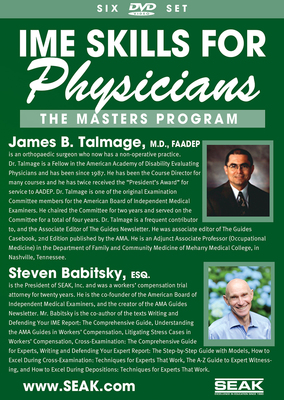Ama Guide To Permanent Impairment 4th Edition
Posted : adminOn 5/14/2018On the other hand, the SSA defines disability as 'the inability to engage in any substantial, gainful activity by reason of any medically determinable physical or mental impairment(s), which can be expected to result in death or which has lasted or can be expected to last for a continuous period of not less than 12 months.' [,,, ] Workers' compensation systems usually define disability as a reduction in wage-earning capacity as a result of an injury, illness, or occupational disease that arose out of, or in the course of, employment. Distinguishing the difference between impairment and disability is imperative.


One individual can be impaired significantly and have no disability, while another person can be quite disabled with only limited impairment. For example, a person with paraplegia who is wheelchair-bound may be working full time quite successfully as an accountant and, therefore, would not meet the SSA's definition of disability. On the other hand, a concert pianist might have a relatively minor injury to a digital nerve that severely limits his/her ability to perform basic work activities (playing difficult piano concertos). Fabfilter Total Bundle Keygen Mac Crack. In some disability systems, a person in this situation might meet the definition of disabled even though he/she can do other work. Because of this difference between impairment and disability, physicians are encouraged to rate impairment based on the level of impact that the condition has on the performance of activities of daily living (ADL) rather than on the performance of work-related tasks. [] According to the AMA Guides, impairment ratings derived from the Guides are 'a physician-driven first approximation of a process that attempts to link impairment with a quantitative estimate of functional losses in' the patient's 'personal sphere of activity.' Disability can be temporary or permanent, and it can be partial or total.
Twice the State average weekly earnings. Unallocated claims. The Guides to the Evaluation of. Permanent Impairment. (AMA Guides – 4th. Edition) – Injuries on. Impairment assessment training - welcome - AMA Victoria delivers courses in Impairment Assessment using the American Medical Association Guides to the Evaluation of Permanent Impairment 4th Edition guide to the.
[, ] Various programs have various categories of disability. An individual can be temporarily unable to perform work activity for remuneration or profit (for example, after trauma, surgery, and/or intensive care) and can be classified as disabled under some disability programs. However, if recovery occurs within 12 months, the individual is not likely to be classified as disabled under the SSA's permanent disability program. Many workers' compensation systems allow for partial disability, generating a need for the AMA Guides to measure the extent of the impairment as related to normal functional capacity. [,, ] The SSA disability program, on the other hand, is an all-or-nothing type of program; the claimant is considered either entirely disabled or not disabled. The Americans with Disabilities Act (ADA) confuses the definition of disability even further.
According to the act, disability is present if at least 1 of the following requirements has been fulfilled: •. Maplestory V62 Download. Different systems to measure impairment The AMA Guides offer one system for measuring impairment, but the guidelines that are provided are not universally accepted and, in fact, are based largely on consensus rather than on scientific evidence. Even with the updated sixth edition of the AMA Guides, there are many jurisdictions that do not recognize their use for impairment measurement in workers' compensation cases. The sixth edition of the Guides boldly attempts to provide more information about the impact of impairment on function, but this blurs the lines between impairment and disability; the goal is lofty, but the execution is difficult.
The AMA Guides continue to allow for substantial subjective interpretation by the examiner, leading to subsequent interrater variability of impairment ratings in practice. For example, the fifth edition of the AMA Guides measures impairment to by range of motion (ROM), gait, muscle weakness, or sensory abnormalities. [, ] Furthermore, the AMA Guides allow for impairment to be rated based on surgical procedures, such as meniscectomy, or by radiographic evidence of joint space narrowing. These assessments are all reasonable methods of determining impairment. The sixth edition of the AMA Guides changes the methodology and adds a subjective factor called the functional history net modifier, which allows for an increase in the total motion impairment based on a subjective report of functional loss.
Furthermore, the sixth edition allows for grading of diagnosis-based impairments with 'severity grades' within different classes; this again interjects subjectivity, which can in turn increase interrater variability. For example, a knee condition might be class 0 (0% impairment) to class 4 (50-100% impairment), with the actual impairment number within the class range being determined by a grade rating of A-E. The grade is determined by factors such as functional history modifier, physical examination modifier, and clinical studies modifier.